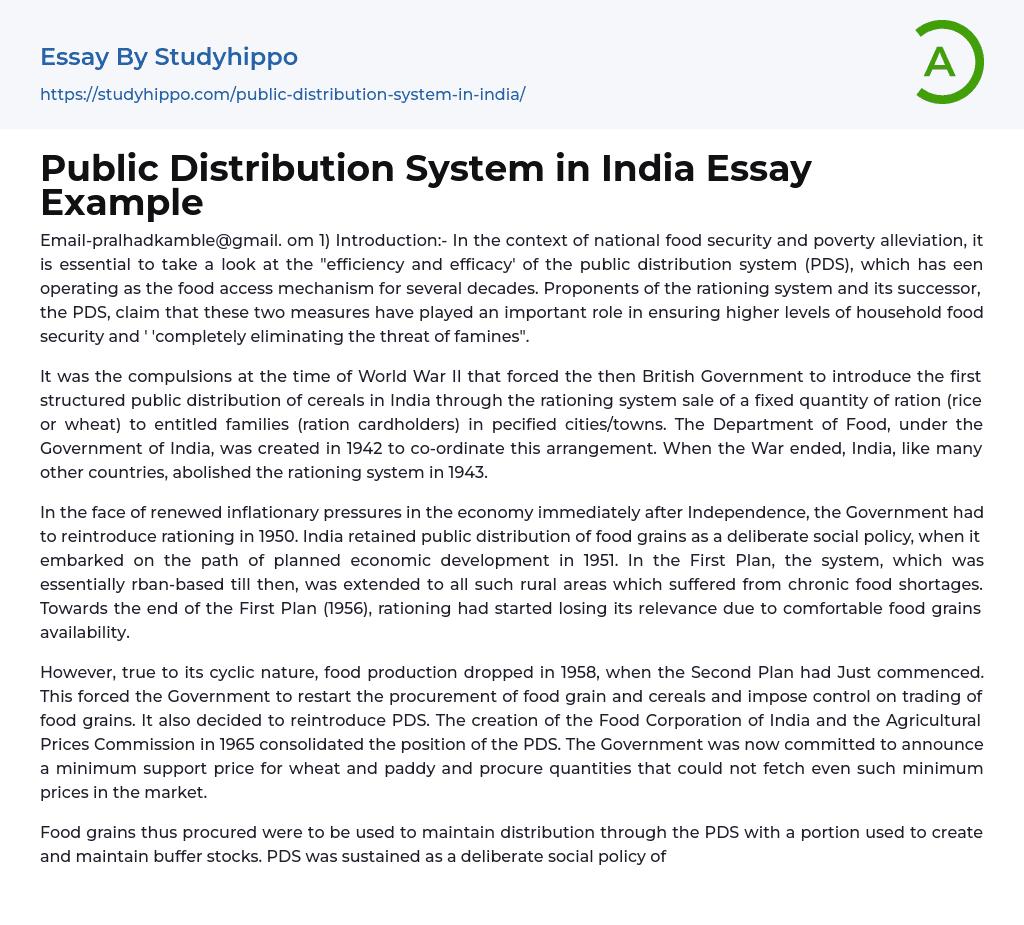It was the compulsions at the time of World War II that forced the then British Government to introduce the first structured public distribution of cereals in India through the rationing system sale of a fixed quantity of ration (rice or wheat) to entitled families (ration cardholders) in pecified citie towns. The Department of Food, under the Government of India, was created in 1942 to co-ordinate this arrangement. When the War ended, India, like many other countries, abolished the rationing system in 1943.
In the face of renewed inflationary pressures in the economy immediately after Independence, the Government had to reintroduce rationing in 1950. India retained public distribution of food grains as a deliberate social policy, when it embarked on the path of planned economic development in 1951. In the First Plan, the system, which was ess
...entially rban-based till then, was extended to all such rural areas which suffered from chronic food shortages. Towards the end of the First Plan (1956), rationing had started losing its relevance due to comfortable food grains availability.
However, true to its cyclic nature, food production dropped in 1958, when the Second Plan had Just commenced. This forced the Government to restart the procurement of food grain and cereals and impose control on trading of food grains. It also decided to reintroduce PDS. The creation of the Food Corporation of India and the Agricultural Prices Commission in 1965 consolidated the position of the PDS. The Government was now committed to announce a minimum support price for wheat and paddy and procure quantities that could not fetch even such minimum prices in the market.
Food grains thus procured were t
be used to maintain distribution through the PDS with a portion used to create and maintain buffer stocks. PDS was sustained as a deliberate social policy of the Government with the objectives of: Providing food grains and other essential items to vulnerable sections of society at reasonable (subsidized) prices; Having a moderating influence on the open market prices of ereals, the distribution of which constitutes a fairly big share of the total marketable commodities; In short, PDS, from mere rationing, had evolved into the National Food Security System.
Both Central & State governments made arrangements to procure essential commodities & supply them through the public distribution outlets. In the case of food grains, Food Corporation of India (FCI) undertook the necessary operations. Moreover, the Central government shoulders the responsibility of procurement, storage & bulk allocation of food grains to the State governments, here as State take active role in identification of families Below Poverty Line (BPL), issuing supply cards, allotment of commodities & supervision & monitoring the functions of ration shops.
- Overpopulation essays
- Homelessness essays
- Hunger essays
- Dumpster Diving essays
- Homelessness In America essays
- Agriculture essays
- Albert einstein essays
- Animals essays
- Archaeology essays
- Bear essays
- Biology essays
- Birds essays
- Butterfly essays
- Cat essays
- Charles Darwin essays
- Chemistry essays
- Dinosaur essays
- Discovery essays
- Dolphin essays
- Elephant essays
- Eli Whitney essays
- Environmental Science essays
- Evolution essays
- Fish essays
- Genetics essays
- Horse essays
- Human Evolution essays
- Isaac Newton essays
- Journal essays
- Linguistics essays
- Lion essays
- Logic essays
- Mars essays
- Methodology essays
- Mineralogy essays
- Monkey essays
- Moon essays
- Mythology essays
- Noam Chomsky essays
- Physics essays
- Plate Tectonics essays
- Progress essays
- Reaction Rate essays
- Roman Numerals essays
- Scientific essays
- Scientific Method essays
- Scientist essays
- Seismology essays
- Space Exploration essays
- Stars essays




